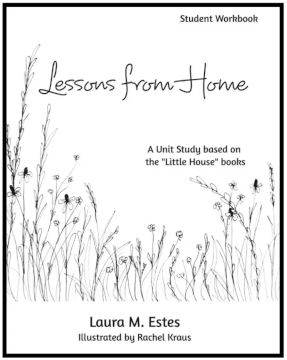Lessons from Home: A Unit Study Based on the Little House Books covers all nine books in that series but can also be used to study individual books. Included among the nine books are The First Four Years and Farmer Boy, which some might not consider part of the main series.
The course consists of a teacher manual and a student workbook, both printed in black and white. Written for students in grades four through six, this unit study provides subject area coverage primarily for literature, composition, and social studies, with less coverage of geography, nature studies, art, cooking, and practical skills. Younger students can participate as much as they are able, especially by listening to the stories and joining some of the discussions and activities.
The Lessons for most chapters are set up to cover four chapters of a book each week. Following the suggested schedule, you will read two chapters each on Mondays and Wednesdays. Tuesdays and Thursdays are for discussions, answering questions, and completing activities such as drawings, map work (on the outline map included in the student book), and compositions. Fridays can be used as make-up days or for extended activities such as art projects and cooking. (A few recipes are included in the student workbook, such as those for sourdough biscuits and hardtack.)
Most of the lessons consist primarily of comprehension questions, but some questions require deeper levels of thinking. The occasional writing assignments definitely take students deeper with a series of questions to consider and incorporate into their writing.
Drawing activities are sometimes included within the student workbook, but templates for others that take longer are in the “My Little House Art” section within the “Additional Resources” that make up the last 67 pages of the student workbook. Other resources found there are additional reading suggestions, Bible references for some of the Little House books, and vocabulary terms for seven of the books (with words listed by chapter, making it easy to have students write definitions for new words).
The lessons for two books are very different from the others. For The Long Winter, the student workbook presents a study of selected psalms, correlating them with excerpts from the story. Students have lines on which to write their own thoughts for each of these psalms and their concluding thoughts at the end. And for Little Town on the Prairie, students construct and write in a journal from the point of view of one of the characters in the story other than Laura. Lined pages are provided for one entry per chapter.
The teacher manual repeats the questions and provides suggested answers. At 146 pages, it is about 100 pages shorter than the student workbook because it omits the rectangles for students to draw in, lines on which students can write, and the Additional Resources section. The course can be used in an open-and-go fashion for all but the recipes, so parents can use it without preplanning. That makes it easy to slot it into your schedule whenever you wish.
Lessons from Home is based upon a perspective that is both Christian and multicultural. The Little House series itself portrays a Christian family operating within a Christian culture. The study occasionally reinforces Christian faith with activities like “Look up the following verse and copy it with your best handwriting: Philippians 2:4” and “Listen: ‘The Sweet Sabbath School Song.’” (The YouTube® URL is in the teacher manual.) (Student workbook, pp. 42 and 82, respectively). In addition, the study of psalms for The Long Winter is entirely Bible-based.
Multiculturalism manifests in several ways. For instance, children learn about the Native Americans with whom Laura’s family interacted and learn to speak a few Swedish phrases. The lessons challenge students to evaluate their own attitudes toward Native Americans in light of what they learn through the stories.
Flexibility
Lessons from Home fits in especially well during the year you study westward expansion in the U.S. but can be used at any time. You can complete the study in one year, but you might instead study just a few books per year over two or three years or skip a few books entirely. Using the entire study in a year will provide most or all of your language arts coverage; you might add grammar and spelling if needed. For grades four through six, I would consider it supplementary for social studies and science, but it might provide sufficient social studies coverage for a second or third grader.
The study can also be adapted easily to fit the needs of students. Parents can choose which activities to do and how to do them. For instance, a child who struggles with writing might answer questions orally while others write answers in the student workbook. Parents might require some students to create a notebook with new vocabulary words and their definitions. Students who have the time can add to the map in the student notebook as Laura moves to and visits different locales, and geographical features might be added to develop a better understanding of geography.
Summary
Fans of the Little House books should find Lessons from Home easy to fit into their curriculum since it can be used as a primary part of your curriculum, a supplement, or just to take a break from more traditional learning activities.












